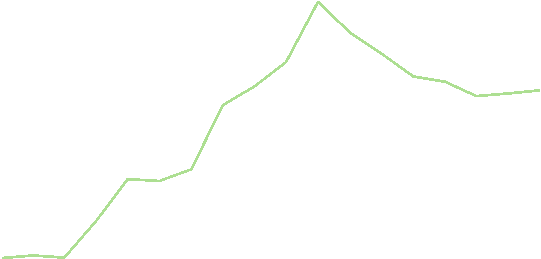


THIS FILING LETTER DOES NOT CONTAIN ANY PRIVILEGED OR
CONFIDENTIAL INFORMATION. ATTACHMENT I - THE BODY OF REPORT,
ALONG WITH THE REDACTED VERSIONS OF TABLES 2 THROUGH 6 (MARKED PUBLIC) DOES NOT CONTAIN ANY PRIVILEGED OR CONFIDENTIAL
INFORMATION. ATTACHMENT II - CONFIDENTIAL TABLES AND DEMAND SIDE ANCILLARY SERVICES PROGRAM DETAILS, INCLUDES THE
UNREDACTED TABLES, WHICH CONTAIN PRIVILEGED AND CONFIDENTIAL INFORMATION, AND IS SUBMITTED SEPARATELY.
January 15, 2019
Kimberly D. Bose, Secretary
Federal Energy Regulatory Commission 888 First Street, N.E.
Washington, D.C. 20426
Re: Annual Report in Docket No. ER01-3001-000;
Request for Privileged Treatment of Attachment II
Dear Ms. Bose:
Enclosed for filing in the above-referenced docket is the New York Independent System Operator Inc.’s (“NYISO”) annual report to the Federal Energy Regulatory Commission
(“Commission”) on the NYISO’s Demand Side Management programs. By Order dated
February 23, 2010, the Commission directed the NYISO to file this report for informational purposes only, and without Commission notice.1
I. List of Documents Submitted
The NYISO submits this filing letter, accompanied by: (i) Attachment I, the NYISO 2018
Annual Report on Demand Response Programs, which includes redactions in Tables 2 through 6
of confidential, commercially sensitive information, and (ii) Confidential Attachment II, which
contains the unredacted versions of the tables (labeled as Tables C-2 through C-6), and an update
1 New York Indep. Sys. Operator, Inc., Letter Order, Docket Nos. ER01-3001-021, et al. (Feb. 23, 2010).
Honorable Kimberly D. Bose January 15, 2019
Page 2
on the status of resources participating in the NYISO’s Demand Side Ancillary Service Program (Table C-7).2
II. Request for Confidential Treatment of Attachment II
In accordance with Sections 388.107 and 388.112 of the Commission’s Regulations,3
Article 6 of the NYISO’s Market Administration and Control Area Services Tariff, and Sections
12.1(4) and 12.4 of the NYISO’s Code of Conduct in Attachment F of the NYISO Open Access
Transmission Tariff, the NYISO requests Privileged and Confidential treatment of the contents
of Attachment II to this filing letter. The NYISO also requests that the confidential Attachment
II be exempted from public disclosure under the Freedom of Information Act (“FOIA”), 5 U.S.C.
§552.4
Attachment II includes information regarding the number of demand response resources
located in load zones that have five or fewer participating resources.5 With such a small number
of demand response resources in a load zone, the NYISO’s aggregation of the data reported for
that load zone may not sufficiently mask confidential and commercially sensitive Market
Participant information that the NYISO does not otherwise make public. Attachment II also
includes a brief discussion of the status of enrollment and registration for the resources seeking
to participate in the NYISO’s Demand Side Ancillary Services Program. The number of
resources addressed is, similarly, small enough that it may not sufficiently mask confidential and
commercially sensitive Market Participant information that the NYISO does not otherwise make
public.
Attachment II, therefore, contains privileged, commercially sensitive, trade secret
information that is exempt from disclosure under 5 U.S.C. §552(b)(4). Disclosure of such
information could cause competitive harm to the affected Market Participants, and could
adversely affect competition in the markets administered by the NYISO. For this reason, the
NYISO requests that the contents of Attachment II receive Privileged and Confidential treatment and be exempt from FOIA disclosure. Attachment II is identified and marked in accordance with the Commission’s regulations and rules published by the Secretary’s Office for submitting
Privileged information.
2 Capitalized terms not defined herein have the meaning set forth in NYISO’s Market Administration and Control Area Services Tariff Section 2.
3 18 C.F.R. §§ 388.107 and 388.112 (2015).
4 The information provided by the NYISO for which the NYISO claims an exemption from FOIA disclosure is labeled “Contains Privileged Information - Do Not Release.”
5 Non-Confidential Attachment I contains data for load zones with more than five participating resources.
Honorable Kimberly D. Bose January 15, 2019
Page 3
III. Correspondence
Copies of correspondence concerning this filing should be addressed to:
Karen G. Gach, Acting General Counsel Raymond Stalter, Director of Regulatory Affairs * Gregory J. Campbell, Attorney
New York Independent System Operator, Inc.
10 Krey Boulevard
Rensselaer, NY 12144
Tel: (518) 356-6000
Fax: (518) 356-4702
rfernandez@nyiso.com
rstalter@nyiso.com
gcampbell@nyiso.com
* Persons designated for service.
*Ted J. Murphy
Hunton Andrews Kurth
2200 Pennsylvania Avenue, NW Washington, D.C. 20037
Tel: (202) 955-1500
Fax: (202) 778-2201
tmurphy@hunton.com
Kevin W. Jones
*Michael J. Messonnier, Jr.6 Hunton Andrews Kurth
951 East Byrd Street
Richmond, VA 23219
Tel: (804) 788-8200
Fax: (804) 344-7999
kjones@hunton.com
mmessonnier@hunton.com
6 The NYISO respectfully requests waiver of 18 C.F.R. § 385.203(b)(3) (2011) to permit service on counsel for the NYISO in both Washington, D.C. and Richmond, VA.
Honorable Kimberly D. Bose January 15, 2019
Page 4
IV. Conclusion
WHEREFORE, the New York Independent System Operator, Inc. respectfully requests that the Commission accept this informational filing and treat the contents of Attachment II as Privileged and Confidential and exempt from FOIA disclosure.
Respectfully submitted,
/s/ Gregory J. Campbell
Attorney
New York Independent System Operator, Inc.
10 Krey Boulevard
Rensselaer, New York 12144 (518) 356-8540
cc:Nicole Buell
Anna Cochrane
James Danly
Jignasa Gadani
Jette Gebhart
Kurt Longo
David Morenoff
Daniel Nowak
Larry Parkinson
Douglas Roe
Kathleen Schnorf Gary Will
CERTIFICATE OF SERVICE
I hereby certify that I have this day served the foregoing document upon each person
designated on the official service list compiled by the Secretary in this proceeding in accordance with the requirements of Rule 2010 of the Rules of Practice and Procedure, 18 C.F.R. §385.2010.
Dated at Rensselaer, NY this 15th day of January 2019.
/s/ Joy A. Zimberlin
Joy A. Zimberlin
New York Independent System Operator, Inc.
10 Krey Blvd.
Rensselaer, NY 12144 (518) 356-6207
NYISO Annual Report in Docket No. ER01-3001-000
Attachment I
NYISO 2018 Annual Report on Demand Response Programs
I.Program Descriptions
The New York Independent System Operator, Inc. (“NYISO”) administers four demand response programs to enhance system reliability and reduce overall production costs.
Two of the programs—the Emergency Demand Response Program (“EDRP”)1 and the
Installed Capacity - Special Case Resource (“ICAP/SCR”) program—support the reliability of the
New York Control Area. Both programs are designed to reduce power consumption by directing
demand response resources to reduce load or to use qualified Local Generators to remove load from
the system during grid emergencies or when reserve shortages are anticipated or actually occur. All
New York Control Area (“NYCA”) Loads are eligible to take part in these programs. Aggregators
enroll Demand Side Resources and coordinate with the NYISO to notify resources when the
NYISO deploys demand response.
The NYISO also offers two economic demand response programs: the Day-Ahead Demand Response Program (“DADRP”) in the Energy market, and the Demand-Side Ancillary Services
Program (“DSASP”) in the Ancillary Services market. The DADRP allows NYCA Loads to offer their load reductions into the Day-Ahead Market (“DAM”) to supply Energy. This program allows flexible loads to effectively increase the amount of supply in the market and moderate Energy
prices. The DSASP provides program participants with an opportunity to offer their load
curtailment capability into the DAM and/or Real-Time Market (“RTM”) to provide Operating
Reserves and Regulation Service.
Each of the four programs is described in greater detail below. Emergency Demand Response Program
The EDRP offers Demand Side Resources the opportunity to earn the greater of $500/MWh or the prevailing Locational-Based Marginal Price (“LBMP”) for curtailing energy consumption when called upon to reduce Load by the NYISO. EDRP resources are enrolled by Curtailment Service Providers (“CSPs”), which serve as the interface between the NYISO and resource.2 Load curtailment by EDRP resources during NYISO-called events is voluntary.
1 Capitalized terms not defined herein have the meaning ascribed to them in the NYISO’s Market Administration and Control Area Services Tariff (“Services Tariff”).
2 An individual EDRP resource may, if it meets the applicable registration requirements, act as its own CSP.
1
Installed Capacity - Special Case Resource Program
Special Case Resources (“SCRs”) are a type of Demand Side Resource that may offer
Unforced Capacity (“UCAP”) into the NYISO’s ICAP market as ICAP Suppliers. SCRs are
enrolled by Responsible Interface Parties (“RIPs”) which may aggregate multiple SCRs and which serve as the interface between the NYISO and the resources.3 Resources may be enrolled in either the EDRP or the ICAP/SCR program, but not both. SCRs that have sold ICAP are obligated to reduce their load when called upon by the NYISO with two or more hours in-day notice, and with day-ahead notice from the NYISO.
In addition to receiving a capacity payment for the SCRs they enroll, RIPs are eligible to
receive Energy payments during an event or test, based on hourly market prices, plus a Bid
Production Cost Guarantee (“BPCG”) payment to make up for any difference between the market
price received and their block offer price across the day. Energy payments are calculated using the
same performance calculation used by the NYISO to pay for the performance of EDRP resources.
Enrolled SCRs must verify their enrolled load reduction capability in each Capability Period through actual performance in an event or test. Failure of an SCR to reduce load during an event or test may result in penalties being assessed to the applicable RIP in accordance with the NYISO’s Services Tariff and the ICAP/SCR program rules and procedures.
Targeted Demand Response Program
The Targeted Demand Response Program (“TDRP”), introduced in July 2007, is a
reliability-based demand response program that deploys existing wholesale market EDRP resources
and SCRs on a voluntary basis in targeted sub-load pockets to solve local reliability problems at the
request of a Transmission Owner. The TDRP program is currently available only in Load Zone J
(New York City). RIPs are eligible to receive Energy payments during an event or test based on
hourly market prices plus a BPCG payments. Energy payments are calculated using the same
performance calculation used by the NYISO to pay for the performance of EDRP resources.
Day-Ahead Demand Response Program
The DADRP allows Demand Side Resources to offer load curtailment into the DAM as an
Energy supply resource. Resources participating in the DADRP submit offers by 5:00 a.m.
specifying the hours and amount of load curtailment for the following day, and the price at which
they are willing to curtail. The offer floor price for the period January 1, 2018 through October 31,
3 An individual SCR may, if it meets the applicable registration requirements, act as its own RIP.
2
2018 was $75/MWh. The NYISO implemented tariff revisions to comply with FERC Order No. 745 for the Day-Ahead Market day November 1, 2018. The offer floors for November and
December 2018, respectively, were $38.36 and $59.25.
DADRP offers are structured like those of generation resources: they specify minimum and maximum run times and the hours in which they are available. Demand Side Resources with Load reductions scheduled in the DAM are obligated to curtail the next day. DADRP resources are also eligible for BPCG payments. Failure of a DADRP resource to curtail its Load may result in
penalties being assessed to the applicable resource in accordance with the NYISO’s Services Tariff and the DADRP program rules and procedures.
Demand-Side Ancillary Services Program
The DSASP provides Demand Side Resources (that meet telemetry and other qualification
requirements) an opportunity to offer their load curtailment capability into the DAM and/or RTM to
provide Operating Reserves and Regulation Service. Resources must qualify through standard
resource testing requirements in order to provide these services. Offers are submitted through the
same process as generation resources: resources participating in the DAM submit offers by 5:00
a.m. specifying the Ancillary Service they are offering (Operating Reserves, and/or Regulation
Service) along with the hours and amount of load curtailment for the following day, and the price at
which they are willing to curtail. DSASP resources are not eligible to be scheduled to provide
Energy in the DAM. DSASP resources may also submit RTM offers up to 75 minutes before the
hour of the offer.
The dispatch of the DSASP resources’ Operating Reserves to Energy is determined in the RTM by the Real-Time Dispatch (“RTD”) software. When RTD instructs a DSASP resource to provide Energy, the DSASP resource must decrease the Load being served by the NYISO. The dispatch of Regulation Service into Energy is issued in the RTM via an Automatic Generation Control (“AGC”) signal. Depending on system needs, the AGC may instruct DSASP resources to either increase or decrease the NYISO-scheduled Energy they are consuming.
DSASP resources that are converted to Energy in real-time are not paid for that Energy.
Instead, DSASP resources are eligible to receive a Day-Ahead Margin Assurance Payment
(“DAMAP”) to make up for any balancing differences between their Day-Ahead Operating
Reserves or Regulation Service schedule and their real-time dispatch. Eligibility to receive
DAMAP is subject to performance requirements. Performance indices are calculated on an interval basis for both Operating Reserves and Regulation Service. DAMAPs are adjusted by the
performance index for the services provided.
3
II.2018 Program Summary
EDRP and ICAP/SCR Program
As of July 31, 2018, a total of 29 CSPs and RIPs had eligible resources enrolled in the
NYISO’s EDRP and ICAP/SCR program.4 Participating CSPs and RIPs include:5
•2 Transmission Owners (“TOs”);
•15 Competitive Load Serving Entities (“LSEs”) that are not TOs;
•12 Aggregators that are not a LSE or TO; and
These figures represent a net increase of three CSPs/RIPs from 2017. This was a result of reduction of two aggregators, and an increase of eight LSEs.
As of July 31, 2018, a total of 3,675 end-use locations were enrolled in the NYISO’s EDRP
and ICAP/SCR programs. These locations were capable of providing a total of 1,314.6 MW of
demand response. This corresponded to a 6.29% increase in the enrolled MW versus 2017, and
represents 4.13% of the 2018 Summer Capability Period peak demand of 31,861 MW. Of the 3,675
end-use locations, 75 participated in the EDRP program, seven were ICAP/SCR resources with
unsold capacity,6 and the remaining 3,593 end-use locations participated in the NYISO’s
ICAP/SCR program. The ICAP/SCR program represents 97.8% of the total resources enrolled in
the NYISO’s reliability-based demand response programs and 99.6% of the total MW enrolled in
those programs.
4 For several years, the date customarily used for reporting the NYISO’s demand response program participation
statistics was August 31. In 2011, the NYISO changed its reporting date from August 31 to July 31 to better align with several other reliability and planning reporting requirements. A July 31 reporting date also provides better transparency with other reporting requirements for the NYISO’s demand response programs. The NYISO has evaluated the
difference in enrollment between July and August and found it to be de minimis (2-3%). The data provided herein is based on a snapshot of the programs on July 31, 2018.
5 In previous reports, the NYISO identified four categories of curtailment service providers. In addition to the three
categories described in this report, the NYISO identified an additional organizational category called “Direct Customer” for entities that registered as a Market Participant with the NYISO to participate on their own behalf in any of the
NYISO’s demand response programs. The NYISO is able to distinguish between the categories of curtailment service provider based on provider name and certain data provided by the Market Participant. The NYISO does not require
Market Participants to identify the category of provider in which they fit. Over the last few reporting cycles, it has
become increasingly difficult to identify Direct Customers based on the information provided to the NYISO and to
provide the Commission with an accurate accounting of such providers. To maintain better consistency of reporting and accuracy, the NYISO has removed the “Direct Customer” organizational category, and merged those providers into the Aggregator or Competitive LSE category as appropriate.
6 ICAP/SCR Resources with unsold capacity are those resources that did not sell their full available capacity.
4
Aggregators and competitive LSEs currently represent 96.5% of enrolled MW in EDRP and ICAP/SCR, up from 95.9% of enrolled MW in 2017. The remaining 3.5% of MW are enrolled by TOs. In 2018, one non-TO market participant enrolled resources in the EDRP (out of three total
EDRP participants), all other EDRP resources were enrolled through their TO. In the ICAP/SCR
program, one participant enrolled through its TO, while all other ICAP/SCR resources were
enrolled through other sources.
The TDRP, which deploys EDRP and ICAP/SCR resources in the various sub-load pockets
in Zone J for local reliability, includes 46.67% of the total New York Control Area (“NYCA”)
EDRP end-use locations and 9.3% of total NYCA EDRP MW. The TDRP also includes 55.6% of
total NYCA ICAP/SCR end-use locations, representing 37.7% of the total NYCA ICAP/SCR MW.
Since 2003, when participation in EDRP and ICAP/SCR became mutually exclusive, the number of EDRP end-use locations and enrolled MW have declined.
Day-Ahead Demand Response Program
DADRP enrollment has been static for several years and enrolled resources have not submitted demand reduction offers for more than four years. DADRP enrollment remained unchanged since the January 2018 Report.
Demand-Side Ancillary Services Program
There are three Demand Side Resources actively participating in the DSASP as providers of Operating Reserves. These resources represent 116.5 MW of capability and had an average
performance of 141.1% during the analysis period of May 2018 through October 2018.
Additional detailed information on participation in the DSASP is found in confidential Attachment II.
III. Reliability Program Participation Detail
Historical Enrollment Data
Historical enrollment data for the NYISO’s reliability demand response programs is
presented in Figure 1. The figure plots the enrollment in the NYISO’s reliability-based programs from inception through July 2018. The stacked bar charts plot enrolled MW by program and year, and the lines plot the number of end-use locations by program and year.
5
From May 2001 through July 2018, combined enrollment in EDRP and ICAP/SCR has grown from approximately 200 MW to 1314.6 MW. The total number of end-use locations has increased from approximately 200 in March 2001 to 3,675 in July 2018. Since participation in EDRP and ICAP/SCR program became mutually exclusive in 2003, the number of participating EDRP resources, and the MW they contribute, has decreased.
Figure 1: Historical Enrollment of
End-Use Locations and MW in NYISO Reliability Programs
3000
2500
2000
1500
1000
500
0
2018
Total End-Use Locations in SCR and EDRP = 3675 Total MW in SCR and EDRP = 1314.6 MW
ICAP Sold End-Use Locations = 3593
EDRP and ICAP Unsold End-Use Locations = 82
ICAP Sold MW = 1309.1 MW ICAP Unsold MW = 0.3 MW EDRP MW = 5.2 MW
200120022003200420052006200720082009
ICAP Sold MWEDRP MWICAP Unsold MW
7000
6000
5000
4000
3000
2000
1000
0
201020112012201320142015201620172018
ICAP Sold Locations EDRP + ICAP Sold and Unsold Locations
Changes in Program Enrollment - 2017-2018
Enrollment data for the NYISO’s reliability-based demand response programs for 2017 -
2018 is provided in Table 1. The number of ICAP/SCR end-use locations and the enrolled MW
have increased since the 2017 report. The number of EDRP end-use locations and the enrolled MW have declined over the past year.
6
Table 1: Program Enrollment by End-Use Location - 2016-2018
20182017
Percent Change From
2017 to 2018
MW per End-use Location
MWLocationEnrolledPercent
CountMWCountMWChangeCountMW20182017Change
EDRP755.29216.3-11.1-18.5%-67.9%0.070.2-60.6%
Unsold70.2671.50-1.20.0%-82.7%0.040.21-82.7%
ICAP Sold35931309.135321219.190.01.7%7.4%0.360.35.6%
Figures 2 and 3 present enrollment statistics in the EDRP and ICAP/SCR program from
2001 - 2018. Figure 2 presents the data by MW enrolled, while Figure 3 presents the data by
number of end-use locations.7 Since making the EDRP and ICAP/SCR program mutually
exclusive, there has been a general decline in the number of enrolled MW and resources in the
EDRP.
Figure 2: Enrollment in the NYISO’s EDRP and ICAP/SCR Program
by MW, 2001-2018
2500
2000
1500
1000
500
0
2001200220032004 2005 2006 2007 2008 2009 2010 2011 2012 2013 2014 2015 2016 2017 2018
EDRP MWICAP Unsold MWICAP Sold MW
7 ICAP/SCR program enrollment of individual end-use locations began in 2004. In 2001 and 2002 end-use locations could enroll in both the EDRP and ICAP/SCR program, but beginning in 2003, resources were prohibited from
simultaneously enrolling in both programs.
7
Figure 3: Enrollment in the NYISO’s EDRP and ICAP/SCR Program
by End-Use Location, 2001-2018
6000
5000
4000
3000
2000
1000
0
2001200220032004 2005 2006 2007 2008 2009 2010 2011 2012 2013 2014 2015 2016 2017 2018
ICAP Sold LocationsEDRP + ICAP Unsold Locations
2017-2018 EDRP and ICAP/SCR Program Enrollments
At the end of July 2018, 3,675 end-use locations, with a total of 1,314.6 MW of demand
response capability, were enrolled in NYISO’s EDRP and ICAP/SCR program. This represents a
6.28% increase from the total enrolled demand response capability in 2017. Of the 3,675 end-use locations, 75 were enrolled in the EDRP and 3,600 were enrolled in the ICAP/SCR program, including SCRs treated as EDRP. ICAP/SCR resources represent 97.78% of the total reliability program end-use locations and 99.60% of the total reliability program MW. Table 2, below,
provides summary data for the EDRP and ICAP/SCR program.
8
Table 2: 2018 Program Enrollment Summary by CSP and RIP Type
EDRPICAP UnsoldICAP Sold
No. of
UniqueAgent Type
MPs
No. of
CSPs
No. of
No. of
End-UseMW
RIPs Locations
No. ofNo. of
No. of
End-UseMWEnd-UseMW
RIPs
Locations Locations
12Aggregator000.02*0.201234641170.2
15Entity1410.51*0.0615*97.4
2Owner/LSE2344.7000.001*41.5
29Total3755.2370.262835931309.1
*Entries in this category have been masked for confidentiality in the public version of this table. The unredacted values are presented in the confidential appendix submitted as Attachment II.
2018 EDRP enrollments were predominantly through TOs, contrasted with the ICAP/SCR program where non-TOs provided 99.94% of participating end-use locations and 96.83% of the
enrolled MW.
Table 3 provides additional program enrollment details by Load Zone. Although the
NYISO does not collect specific resource class data, demand response resources in Load Zones A through E are typically industrial and retail resources, while those in Load Zones J and K include commercial office, retail, and multi-family residential resources.
Table 3: 2018 Program Enrollment by Load Zone
EDRPICAP UnsoldICAP Sold
No. ofNo. ofNo. of
ZoneEnd-UseMWEnd-UseMWEnd-UseMW
LocationsLocationsLocations
A61.200.00237281.0
B*0.300.0018254.6
C121.400.00244117.8
D*0.600.002258.3
E70.9*0.0611140.4
F*0.200.00177103.1
G00.000.0015662.6
H*0.100.003212.3
I60.0*0.1012337.1
J350.5*0.102000493.6
K00.000.0030948.5
Total755.270.2635931309.1
*Entries in this category have been masked for confidentiality in the public
version of this table. The unredacted values are presented in the confidential appendix submitted as Attachment II.
9
ICAP/SCR Resource Aggregations
NYISO identifies ICAP/SCR resource enrollments by end-use location, and they may
represent either individually enrolled end-use locations or aggregations of end-use locations that are enrolled as a single demand response resource. Table 4 contains data on ICAP/SCR program
participation. As of July 31, 2018, 3,554 end-use locations were enrolled in aggregations. These
aggregations provided 1,146.3 MW of the 1,309.1 MW enrolled in the ICAP/SCR program. The
remaining 162.8 MW of demand response capacity in the ICAP/SCR program came from 39
individually enrolled resources.
Table 4: Detail of 2018 ICAP/SCR Program Participation Level by Resource Type
ICAP SoldICAP Unsold
Resource Type
No. of End-Use
Locations
No. of End-Use
MWMW
Locations
Individual Resources39162.8*0.20
Aggregated Resources35541146.3*0.06
Total35931309.170.26
*Entries in this category have been masked for confidentiality in the public version of this table. The unredacted values are presented in the confidential appendix submitted as Attachment II.
Table 4 also provides information for ICAP/SCR resources that did not sell any capacity in
the July 2018 capacity market auctions. This information is included because when an ICAP/SCR
resource offers its load reduction in a NYISO auction and that load reduction is not sold (or when a
resource’s derated MW value is zero), the resource’s enrolled capacity is automatically included in
the EDRP.8
TDRP Enrollment
Load Zone J is currently the only Load Zone with resources participating in the TDRP. This
Load Zone has been divided into sub-load pockets designated by Consolidated Edison Company of
New York, Inc. (“Con Edison”). Resources enrolled in the EDRP and ICAP/SCR program are
8 The resource will remain in the EDRP until it clears in a subsequent auction, or the resource confirms a bilateral transaction with an LSE. The EDRP enrollment totals and event response data included in this report include the offered, but unsold, MW of enrolled ICAP/SCR resources.
10
assigned to one of the various sub-load pockets based on their location.9 Resources that are not
assigned to a particular sub-load pocket remain in the general Zone J category. Tables 5 and 6
provide EDRP and ICAP/SCR end-use locations and MW enrolled in the TDRP by sub-load
pocket.
Table 5: EDRP End-Use Locations Enrolled in TDRP
Zone/SubzoneJJ1J2J3J4J5J6J7J8J9Total
MW0.00.00.00.10.00.00.10.20.20.00.5
No. of End-Use
Locations000110**98035
*Entries in this category have been masked for confidentiality in the public version of this table. The unredacted values are presented in
the confidential appendix submitted as Attachment II.
Table 6: ICAP/SCR End-Use Locations Enrolled in TDRP
Zone/SubzoneJJ1J2J3J4J5J6J7J8J9Total
MW1.240.436.072.831.142.583.361.6124.80.0493.7
No. of End-Use
Locations*191147366*20724428048602003
*Entries in this category have been masked for confidentiality in the public version of this table. The unredacted values are presented in the confidential appendix submitted as Attachment II.
Analysis of ICAP/SCR Strike Prices
Starting in 2003, resources participating in the ICAP/SCR program were required to provide a curtailment strike price - between $0 and $500/MWh - to the NYISO at the time of enrollment. Strike Prices are used by the NYISO in the calculation of Energy payments.
The NYISO has analyzed strike price curves for all resources enrolled as of July 2018 and
compared the most recent strike price curves to prior years. Figures 4 and 5 below map the
percentage of enrolled ICAP/SCR MW at a given strike price. Figure 4 illustrates the strike price
curves for the period 2003 to 2018, the entire period in which resources were required to provide
strike prices. The steep slope of the strike price curves indicate that strike prices are clustered close
to the offer ceiling of $500/MWh. The data indicates that, as the program has evolved since 2003,
the number of resources providing strike prices at or near $500/MWh has increased, with greater
than 93.94% of enrolled ICAP/SCR MW submitting a strike price at the $500/MWh limit in 2018;
5.99% ICAP/SCR MW submitted a strike price of $499/MWh, and the remaining 0.07% submitted a strike price below $499/MWh.
9 The Load Zone J sub-load pockets are: J1 - Sherman Creek/Parkchester/E 179th; J2 - Astoria West/Queensbridge; J3
- Vernon/Greenwood; J4 - Staten Island; J5 - Astoria East/Corona/Jamaica; J6 - W 49th; J7 - East 13th/East River; J8 -
Farragut/Rainey; and J9 - Shared sub-load pocket.
11
Figure 4: ICAP/SCR Curtailment Strike Price Bid Curves, 2003-2018
500
450
400
350
300
250
200
150
100
50
0
0%
25%50%
% of Total MW
2018 (1309.1 MW)
2017 (1219.1 MW)
2016 (1191.8 MW)
2015 (1248.3 MW)
2014 (1124.4 MW)
2013 (1175.2 MW)
2012 (1741.1 MW)
2011 (1976.2 MW)
2010 (2238.5 MW)
2009 (2060.6 MW)
2008 (1743.8 MW)
2007 (1338.5 MW)
2006 (1216.2 MW)
2005 (1083.8 MW)
2004 (980.8 MW)
2003 (758 MW)
75%
100%
Figure 5 provides a detailed view of the strike price curves for 2014 through 2018, and
shows the percentage of offers made below the $500/MWh ceiling. As stated above, 93.94% of
enrolled ICAP/SCR MW submitted a strike price at the $500/MWh limit in 2018; 5.99%
ICAP/SCR MW submitted a strike price of $499/MWh, and the remaining 0.07% submitted a strike price below $499/MWh.
12
Figure 5: ICAP/SCR Curtailment Strike Price Bid Curves, 2014-2018
500
450
400
350
300
1.4%2%2.9%6.1%6.6%
2018 (1309.1 MW)
2017 (1219.1 MW)
2016 (1191.8 MW)
200200
150
100
50
00
0%1%3%4%5%6%8%
% of Total MW
IV. 2018 Event and Test Performance: EDRP and ICAP/SCR Program
NYISO did not activate the EDRP or ICAP/SCR for events during the Winter 2017-2018 Capability Period, however, the EDRP and ICAP/SCR program were activated three times during the Summer 2018 Capability Period for events in Zone J.
Table 7 below provides the date, time, and zone for each performance test conducted during the Winter 2017-2018 and Summer 2018 Capability Periods.
13
Table 7: ICAP/SCR SCR Performance Tests
Capability PeriodDeployment TypeProgramEvent/Test Start TimeEvent/Test End TimeZones
Winter 2017-2018First Performance TestSCR2/22/2018 16:002/22/2018 17:00A, B
Winter 2017-2018First Performance TestSCR2/22/2018 17:002/22/2018 18:00C, D, E, F, G, H, I
Winter 2017-2018First Performance TestSCR2/22/2018 18:002/22/2018 19:00J, K
Summer 2018NYISO EventSCR7/2/2018 13:007/2/2018 18:00J
Summer 2018NYISO EventEDRP7/2/2018 13:007/2/2018 18:00J
Summer 2018NYISO EventSCR8/28/2018 12:008/28/2018 18:00J
Summer 2018NYISO EventEDRP8/28/2018 12:008/28/2018 18:00J
Summer 2018NYISO EventSCR8/29/2018 12:008/29/2018 18:00J
Summer 2018NYISO EventEDRP8/29/2018 12:008/29/2018 18:00J
Summer 2018First Performance TestSCR8/30/2018 13:008/30/2018 14:00A
Summer 2018First Performance TestSCR8/30/2018 14:008/30/2018 15:00B, C, D, E
Summer 2018First Performance TestSCR8/30/2018 15:008/30/2018 16:00J
Summer 2018First Performance TestSCR8/30/2018 16:008/30/2018 17:00F, G, H, I, K
Summer 2018Second Performance TestSCR10/2/2018 13:0010/2/2008 14:00B, D, E, F, J
a.) Test Performance
Each resource participating in the ICAP/SCR program is required to demonstrate its ability to meet its obligated MW once in each Capability Period. The NYISO therefore schedules a onehour performance test in which all SCRs are called to demonstrate their ability (the “First
Performance Test”). RIPs have the option to use a SCR’s performance in a mandatory event as a proxy for its test value in certain circumstances. There were no mandatory events in the Winter 2017-2018 Capability Period, therefore participation in the First Performance Test was mandatory. The only mandatory events for the Summer 2018 Capability Period were in Zone J. Therefore, participation in the First Performance Test was mandatory in all zones except for Zone J. The
NYISO also schedules a Second Performance Test for resources that change certain operational characteristics within a Capability Period (e.g., a Change of Load).
Measurement of performance test response is based on the ICAP/SCR reporting rules contained in the NYISO’s ICAP Manual.
For SCRs that meet their Load reduction obligation solely through curtailment or through a
combination of curtailment and the use of a Local Generator, ICAP/SCR response is determined by
comparing the actual hourly interval metered load with the Average Coincident Load (“ACL”):
ICE_RED_MWgn = (ACLgm - METER_MWgn) * (1+TLFgm)
Load reduction response for SCRs that meet their Load reduction obligation solely through the use of a Local Generator is determined by the actual hourly interval metered load:
14
ICE_RED_MWgn = METER_MWgn * (1+TLFgm)
where:
• ICE_RED_MWgn is the Installed Capacity Equivalent of Response MW that Resource g
supplies during hour n of an SCR event or test;
• ACLgm is the ACL for Resource g applicable to month m, using data submitted in its Special
Case Resource certification;
• METER_MWgn is the metered hourly-integrated load for Resource g in hour n of an SCR event
or test; and
• TLFgm is the Transmission Loss Factor for Resource g applicable to month m, using data
submitted in its Special Case Resource certification
The resource’s Installed Capacity Equivalent response is then compared with the resource’s Installed Capacity Equivalent of the maximum registered megawatt value to determine the resource’s performance.
Tables 8 and 9 provide a summary of ICAP/SCR program performance test response
compared to the Obligated MW for the zones deployed during the tests; Table 8 summarizes
response on a NYCA-wide basis, and Table 9 summarizes response by Zone. Obligated MW is
defined as the Installed Capacity Equivalent of the maximum registered MW value that each SCR is required to demonstrate once in every Capability Period. ICAP Equivalent of Response MW,
reported for each Capability Period, includes MW responses for both First and Second Performance Tests if data is available. For resources that are required to demonstrate performance in both the First and Second Performance Tests, the maximum MW response is reported.10
Because there were three mandatory Zone J events in Summer 2018 RIPs with Demand Side Resources in that Zone had the option to substitute a SCR’s performance during an event as a proxy for its test value. The information reported below includes SCR event performance that was used as a proxy for the performance test.
10 If Verified ACL data is not available at the time of reporting for a resource enrolled with either a Provisional ACL or
an Incremental ACL, the ACL with which the resource enrolled in the SCR program is used for reporting performance
data.
15
Table 8: Summary of ICAP/SCR Program Performance Test MW Response
Based on ACL Baseline - NYCA-Wide
%
ProgramCapability PeriodZone
ICAP Equivalent Obligated of Response MW ICAP MW
Response
of
Obligated
ICAP MW
SCR (ICAP)Winter (2017-2018)A,B,C,D,E,F,G,H,I,J,K984.7937.6105.0%
SCR (ICAP)Summer (2018)A,B,C,D,E,F,G,H,I,J,K1515.31327.0114.2%
16
Table 9: ICAP/SCR Program Performance Test MW Response
Based on ACL Baseline - By Zone
%
ProgramCapability Period
Zone
ICAP Equivalent
of Response MW
Obligated Response of
ICAP MW Obligated
ICAP MW
SCR (ICAP) Winter (2017-2018)
F60.0
G 33.2
68.387.9%
38.586.4%
ProgramCapability PeriodZone
ICAP EquivalentObligated Response of
of Response MW ICAP MWObligated
ICAP MW
SCR (ICAP)Summer (2018)
F97.1103.693.7%
G 59.4 63.2 93.9%
Total1515.31327.0114.2%
17
In addition to receiving a capacity payment for committing to reduce energy consumption,
RIPs with resources enrolled in the ICAP/SCR program are eligible to receive Energy payments for
reductions made by those resources during a performance test or event, provided that the RIP
submits the required performance data. The amount of load reduction eligible for an Energy
payment is computed using a Customer Baseline Load (“CBL”). Unlike the ACL baseline which
uses a SCR’s Load data from a prior like Capability Period, the CBL uses data from the previous 30
days to establish a baseline which is likely to be a more accurate representation of the resource’s
Load during a performance test or event but for the resource’s response to the NYISO’s deployment
directive. The Energy payment is the difference between the hourly CBL and the corresponding
interval meter readings during performance test hours, multiplied by the applicable LBMP.
Table 10 presents a summary of voluntarily reported CBL data by zone and hour for
ICAP/SCR resources for the Winter 2017-2018 and Summer 2018 Capability Period performance
tests. The information reported in Table 10 only includes the CBL performance during the
performance test that is used for Energy payments. Since the ICAP/SCR ACL values described
above are based on the prior like Capability Period, and the CBL is determined from data up to 30
days prior to performing the tests, the NYISO expects different resource response rates.
Contributing to the difference between the ICAP/SCR ACL response and the CBL response is the
fact that not all RIPs submit CBL energy performance data. The NYISO has observed that some
RIPs report CBL data only for their larger resources, and they are more likely to report CBL data
for resources in Load Zone J, where energy prices are typically higher than in the rest of the NYCA.
18
Table 10: ICAP/SCR Program Performance Test MW Response
Based on CBL Baseline
ProgramCapability PeriodZone
ICAP Equivalent of
Response MW
Obligated
ICAP MW of
SCRs
Reporting CBL
Data
%
Response of
Obligated
ICAP MW
SCR (ICAP)Winter (2017-2018)G24.431.078.5%
ProgramCapability Period
Zone
ICAP Equivalent of
Response MW
Obligated
ICAP MW of
SCRs
Reporting CBL
Data
%
Response of
Obligated
ICAP MW
SCR (ICAP)Summer (2018)G55.856.898.1%
b.) Event Response
During Summer 2018, the NYISO activated SCR and EDRP resources three times in Zone J to maintain transmission security.
• On July 2, 2018, SCRs and EDRP Resources were deployed in Zone J from 13:00 to
18:00. Response for the hours 17:00 - 18:00 was mandatory, but did not trigger
scarcity pricing.11
• On August 28, 2018, SCRs and EDRP Resources were deployed in Zone J from
12:00 to 18:00. Response was mandatory for the entire event, and scarcity pricing
was triggered for a total of thirteen five-minute intervals during the six-hour event.
• On August 29, 2018, SCRs and EDRP Resources were deployed in Zone J from
12:00 to 18:00. Response was mandatory for the entire event, and scarcity pricing
was triggered for a total of two five-minute intervals during the six-hour event.
Table 11 summarizes SCR and EDRP response based on ACL and CBL, respectively, for all
2018 Summer Capability Period events. Obligated MW is defined as the Installed Capacity
Equivalent of UCAP sold by SCRs in a Load Zone during the calendar month in which the event
occurred. When the amount of Obligated MW is less than enrolled MW, it indicates that a portion
of a Load Zone’s enrolled SCR UCAP went unsold for the month of the event. As explained in
Section III, enrolled SCRs that do not sell UCAP in a particular month in a Capability Period are
treated as EDRP resources for that particular month. Available EDRP MW is defined as the
amount of demand response reduction nominated by EDRP resources in a Load Zone.
Table 12 presents a summary of reported CBL data by zone and hour for ICAP/SCR
resources during the three Summer 2018 Capability Period events. Since the ICAP/SCR ACL values described above are based on the prior-like Capability Period, and the CBL is determined from data that ranges up to 30 days prior to the event, the NYISO expects different resource
response rates. Contributing to the difference between the ICAP/SCR ACL response and the CBL response is the fact that not all RIPs submit CBL energy performance data.
11 Additional information on scarcity pricing is available at:
https://www.nyiso.com/documents/20142/3035859/Scarcity-Pricing.pdf.
20
Table 11: Summary of 2018 Event Performance using ACL for SCRs and CBL for EDRP Resources
SCR (using ACL as baseline)EDRP (using CBL as baseline)Reliability Program-wide
Deployment
Type
Event Day Event Start Time
Event End
Zone
Time
ICAP Equivalent
of Average Hourly
Response MW
%
Response Obligated
of
ICAP MW
Obligated
ICAP MW
Average
Hourly
Response
MW
%
Available ResponseTotal
EDRPofResponse
MWAvailableMW
EDRP MW
% Response of Obligated
Obligated ICAP ICAP MW
MW and
and Available
Available EDRP
EDRP MW
MW
NYISO Event7/2/201813:0018:00J405.0493.682.1%0.40.668.7%405.4494.282.0%
NYISO Event8/28/201812:0018:00J401.4479.983.6%0.31.321.2%401.7481.283.5%
NYISO Event8/29/201812:0018:00J387.4479.980.7%0.51.337.5%387.9481.280.6%
NOTE: EDRP Resource performance is calculated using the CBL baseline only. The data presented in Tables 11 and 12, therefore, contains the
same information for EDRP resources.
Table 12: Summary of 2018 Event Performance using CBL for SCRs and EDRP Resources
SCR (using CBL as baseline)EDRP (using CBL as baseline)Reliability Program-wide
Deployment
Type
NYISO Event
NYISO Event
NYISO Event
Event Day
7/2/2018
8/28/2018
8/29/2018
ICAP Equivalent Obligated ICAP
Event Start Event Endof AverageMW of SCRs
Zone
TimeTimeHourlyReporting CBL
Response MWData
13:0018:00 J287.8461.9
12:0018:00 J283.9449.5
12:00 18:00 J 277.9 449.5
% Response
of Obligated
ICAP MW
62.3%
63.2%
61.8%
Average
TotalHourlyAvailable
PaymentResponseEDRP MW
MW
$692,283.30.458.8%
$821,346.00.3131.8%
$803,406.4 0.5 131.8%
% ResponseTotal
Total
of AvailableResponse
Payment
EDRP MWMW
0.7$1,009.8288.2
0.2$841.7284.2
0.4$1,482.2278.4
Obligated ICAP% Response of
MW andObligated ICAPTotal
Available EDRP MW and AvailablePayment
MWEDRP MW
462.562.3%$693,293.1
450.863.0% $822,187.6
450.8 61.8% $804,888.6
V. Economic Demand Response Programs
Day-Ahead Demand Response Program
There have been no offers submitted for DADRP Resources since December 2010. There is, therefore, nothing to report for this period.
Demand Side Ancillary Services Program
Because there is limited participation in the DSASP, detailed information on the program is provided in Confidential Attachment II.
VI. Update on 2018 Demand Response Initiatives
This section provides an update on the status of initiatives that the NYISO has been working
on with its stakeholders to improve the administration of its demand response programs and to
address regulatory directives to facilitate market participation. In particular, the NYISO has
focused on:
• Continued Development of the Demand Response Information System (“DRIS”);
• Compliance with Order No. 745; and
• Enhancing Demand Response in the Real-Time Energy Market by developing a Distributed
Energy Resource participation model
Continued Development of the Demand Response Information System
The NYISO successfully deployed several software improvements to DRIS in Q2 and Q3 2018. These deployments resolved several minor software issues that did not impact market participants, and improved the user interface.
NYISO’s Compliance with Order No. 745
FERC issued an order on January 30, 2017,12 granting rehearing on, and accepting, the
NYISO’s 2011 cost allocation proposal for the Day-Ahead Demand Response Program
(“DADRP”), and accepted the NYISO’s tariff revisions related to the Net Benefits Test, DADRP
Offer Floor, and the use of a new baseline methodology. On March 31, 2017 the NYISO submitted
a compliance filing containing a complete copy of its Order No. 745 tariff amendments. The tariff
12 New York Indep. Sys. Operator, Inc., 158 FERC ¶ 61,081 (Jan. 30, 2017).
22
amendments became effective on October 31, 2018 for the November 1, 2018 Day-Ahead Market day.13 Prior to the tariff amendments becoming effective, the NYISO worked on implementing three major tariff enhancements in compliance with Order No. 745: 1) the Net Benefits Test and DADRP offer floor, 2) the Economic Customer Baseline Load (ECBL) for DADRP measurement and verification, and 3) the allocation of costs of DADRP to transmission customers.
Demand Response in the Real-Time Energy Market via the NYISO’s Distributed Energy Resource Participation Model
The NYISO initiated a project in 2016 to integrate Distributed Energy Resources (DER),
including demand response, into its real-time Energy markets. The primary outcome of this
initiative will be the integration of dispatchable DER.14 In 2017 the NYISO published a DER
Roadmap15 describing NYISO’s vision for integrating these resources into the wholesale markets
and proposed a market design concept to its stakeholders.16 In 2018, the NYISO continued to work
its stakeholders to develop a detailed market design to facilitate dispatchable DER integration. The
NYISO made a total of 31 stakeholder presentations17 to its Market Issues and Installed Capacity
working groups to discuss the market design details related to DER aggregations, energy and
ancillary services market participation, capacity market participation, interconnection, meter data
constructs, and dual participation.
VII. 2019 Demand Response Initiatives
This section provides an overview of the projects that the NYISO has planned for its demand response programs for 2019.
13 New York Indep. Sys. Operator, Inc. March 31, 2018 Compliance Filing, Docket No. ER11-4338-001.
14 The NYISO’s initiative to integrate DER will also include concepts for participation in the NYISO’s capacity and ancillary services markets.
15 New York Indep. Sys. Operator, Inc., Distributed Resources Roadmap for New York’s Wholesale Electricity Markets (Feb. 2018), available at
https://www.nyiso.com/documents/20142/1391862/Distributed_Energy_Resources_Roadmap.pdf.
16 New York Indep. Sys. Operator, Inc., Distributed Resources Market Design Concept Proposal (Dec. 2017), available
at https://www.nyiso.com/documents/20142/1391862/Distributed-Energy-Resources-2017-Market-Design-Concept-
Proposal.pdf.
17 The NYISO’s DER integration related presentations are available at:
https://www.nyiso.com/search?keytopics=Distributed%20Energy%20Resources%20Participation%20Model&sortField
=newest.
23
Continued Development of the Demand Response Information System
The NYISO plans to continue updating its DRIS software to improve the user interface.
Demand Response in the Real-Time Energy Market via the Distributed Energy Resources Roadmap for New York’s Wholesale Electricity Markets
The integration of DER into the NYISO’s markets will continue to be the main driver in demand response innovation for 2019. The NYISO intends to work with its stakeholders to develop a detailed market design and market rules. The NYISO expects to complete the tariff enhancements in 2019 to facilitate dispatchable DER integration.
24
Appendix A: Detailed Event Response for Summer 2018 Demand Response Events
This Appendix A includes additional data on event response for the three activations of the
NYISO’s wholesale SCR Program and EDRP. The following tables are presented for each event:
• Event Summary - average hourly response compared to Obligated or Available MW by
program, and event energy payments by program.
• SCR MW Response Based on ACL - hourly response detail by zone and average hourly
response compared to Obligated MW for the zone.
• SCR Energy Response Based on CBL - response detail by zone and average hourly
response compared to Obligated MW of SCRs that reported CBL data in the zone.
• SCR Energy Payments - hourly energy payments, daily BPCG payments by zone for SCRs
that reported CBL data.
• Energy Response of EDRP Resources and SCRs treated as EDRP - detailed hourly response
by zone, average hourly response, and comparison of average hourly response to enrolled
(also referred to as Available) MW.
•
Energy Payments to EDRP Resources and SCRs treated as EDRP - hourly and total event energy payments by zone.
25
July 2, 2018: Mandatory SCR response for hour beginning 17:00 in Zone J; EDRP response also requested
Table A-1: Event Summary - July 2, 2018
Zone
ICAP Equivalent ofObligated ICAP
Average Hourly ResponseMW or
MW or Average HourlyAvailable
Response MWEDRP MW
% Response of
Obligated ICAP
MW orTotal Payment Available EDRP
MW
SCR (ICAP)J405.0493.682.1%$692,283.3
EDRP and SCRsJ0.40.668.7%$1,009.8
treated as EDRP
Total405.4494.282.0%$693,293.1
Table A-2: SCR MW response Based on ACL - July 2, 2018
ICAP
Zone13:0014:00
Equivalent of
15:0016:0017:00Average
Hourly
Response MW
Obligated
ICAP MW
% Response
of Obligated
ICAP MW
J339.3403.4400.7412.6469.0405.0493.682.1%
Total339.3403.4400.7412.6469.0405.0493.682.1%
Table A-3: SCR MW response Based on CBL - July 2, 2018
Zone13:0014:00
ICAP Equivalent
15:0016:0017:00of Average Hourly
Response MW
Obligated ICAP
MW of SCRs
Reporting CBL
Data
% Response
of Obligated
ICAP MW
J239.3298.8295.4301.7303.8287.8461.962.3%
Total239.3298.8295.4301.7303.8287.8461.962.3%
Table A-4: SCR Energy Payments - July 2, 2018
Zone13:0014:00
Sum ofSum of
15:0016:0017:00LBMPBPCG
PaymentsPayments
Total
Payments
J$22,070.8$16,910.2$17,758.0$17,056.7$16,316.3$ 90,112.0$602,171.4$692,283.3
Total$22,070.8$16,910.2$17,758.0$17,056.7$16,316.3$ 90,112.0$602,171.4$692,283.3
26
Table A-5: Energy response of EDRP Resources and SCRs treated as EDRP - July 2, 2018
Zone13:0014:00
15:0016:0017:00
Average
Hourly
Respons
e MW
%
Available Response
EDRP of
MWAvailable
MW
J0.40.40.30.40.40.40.668.7%
Total0.40.40.30.40.40.40.668.7%
Table A-6: Energy Payments to EDRP Resources and SCRs treated as EDRP - July 2, 2018
Sum of
Zone13:0014:0015:0016:0017:00LBMP
Payments
J$199.3$217.5$170.1$205.5$ 217.5$1,009.8
Total$199.3$217.5$170.1$205.5$ 217.5$1,009.8
August 28, 2018: Mandatory SCR response in Zone J; EDRP response also requested
Table A-7: Event Summary - August 28, 2018
Zone
ICAP Equivalent ofObligated ICAP
Average Hourly ResponseMW or
MW or Average HourlyAvailable
Response MWEDRP MW
% Response of
Obligated ICAP
MW orTotal Payment Available EDRP
MW
SCR (ICAP)J401.4479.983.6%$821,346.0
EDRP and SCRsJ0.31.321.2%$841.7
treated as EDRP
Total401.7481.283.5%$822,187.6
27
Table A-8: SCR MW response Based on ACL - August 28, 2018
ICAP
Zone12:0013:00
Equivalent of
14:0015:0016:0017:00Average
Hourly
Response MW
Obligated
ICAP MW
% Response
of Obligated
ICAP MW
J307.6353.2436.1437.8419.6454.2401.4479.983.6%
Total307.6353.2436.1437.8419.6454.2401.4479.983.6%
Table A-9: SCR MW response Based on CBL - August 28, 2018
Zone12:0013:0014:00
ICAP Equivalent
15:0016:0017:00of Average Hourly
Response MW
Obligated ICAP
MW of SCRs
Reporting CBL
Data
% Response
of Obligated
ICAP MW
J198.8251.9334.5332.4302.3283.6283.9449.563.2%
Total198.8251.9334.5332.4302.3283.6283.9449.563.2%
Table A-10: SCR Energy Payments - August 28, 2018
Zone12:0013:00
14:0015:0016:00
Sum ofSum of
17:00LBMPBPCG
PaymentsPayments
Total
Payments
J$19,157.1$21,668.6$22,938.1$28,493.2$97,446.5$142,199.8$331,903.4$489,442.6$821,346.0
Total$19,157.1$21,668.6$22,938.1$28,493.2$97,446.5$142,199.8$331,903.4$489,442.6$821,346.0
Table A-11: Energy response of EDRP Resources and SCRs treated as EDRP - August 28, 2018
Zone12:0013:00
14:0015:0016:0017:00
Average
Hourly
Respons
e MW
%
Available Response
EDRP of
MWAvailable
MW
J0.20.20.30.40.30.30.31.321.2%
Total0.20.20.30.40.30.30.31.321.2%
28
Table A-12: Energy Payments to EDRP resources and SCRs treated as EDRP - August 28, 2018
Sum of
Zone12:0013:0014:0015:0016:0017:00LBMP
Payments
J$90.1$ 107.4$ 163.2$ 180.2$ 159.7$ 141.2$ 841.7
Total$90.1$ 107.4$ 163.2$ 180.2$ 159.7$ 141.2$ 841.7
August 29, 2018: Mandatory SCR response in Zone J; EDRP response also requested
Table A-13: Event Summary - August 29, 2018
Zone
ICAP Equivalent ofObligated ICAP
Average Hourly ResponseMW or
MW or Average HourlyAvailable
Response MWEDRP MW
% Response of
Obligated ICAP
MW orTotal Payment Available EDRP
MW
SCR (ICAP)J387.4479.980.7%$803,406.4
EDRP and SCRsJ0.51.337.5%$1,482.2
treated as EDRP
Total387.9481.280.6%$804,888.6
Table A-14: SCR MW response Based on ACL - August 29, 2018
ICAP
Zone12:0013:00
Equivalent of
14:0015:0016:0017:00Average
Hourly
Response MW
Obligated
ICAP MW
% Response
of Obligated
ICAP MW
J303.2345.4411.5415.4401.8447.0387.4479.980.7%
Total303.2345.4411.5415.4401.8447.0387.4479.980.7%
29
Table A-15: SCR MW response Based on CBL - August 29, 2018
Zone12:0013:0014:00
ICAP Equivalent
15:0016:0017:00of Average Hourly
Response MW
Obligated ICAP
MW of SCRs
Reporting CBL
Data
% Response
of Obligated
ICAP MW
J197.1250.4323.0320.8292.8283.5277.9449.561.8%
Total197.1250.4323.0320.8292.8283.5277.9449.561.8%
Table A-16: SCR Energy Payments - August 29, 2018
Zone12:0013:00
14:0015:0016:00
Sum ofSum of
17:00LBMPBPCG
PaymentsPayments
Total
Payments
J$18,454.9$22,925.7$23,175.7$77,178.9$37,541.1$17,370.6$196,646.9$606,759.5$803,406.4
Total$18,454.9$22,925.7$23,175.7$77,178.9$37,541.1$17,370.6$196,646.9$606,759.5$803,406.4
Table A-17: Energy response of EDRP Resources and SCRs treated as EDRP - August 29, 2018
Zone12:0013:00
14:0015:0016:0017:00
Average
Hourly
Response
MW
%
Available Response
EDRP of
MWAvailable
MW
J0.30.40.60.70.60.40.51.337.5%









































































